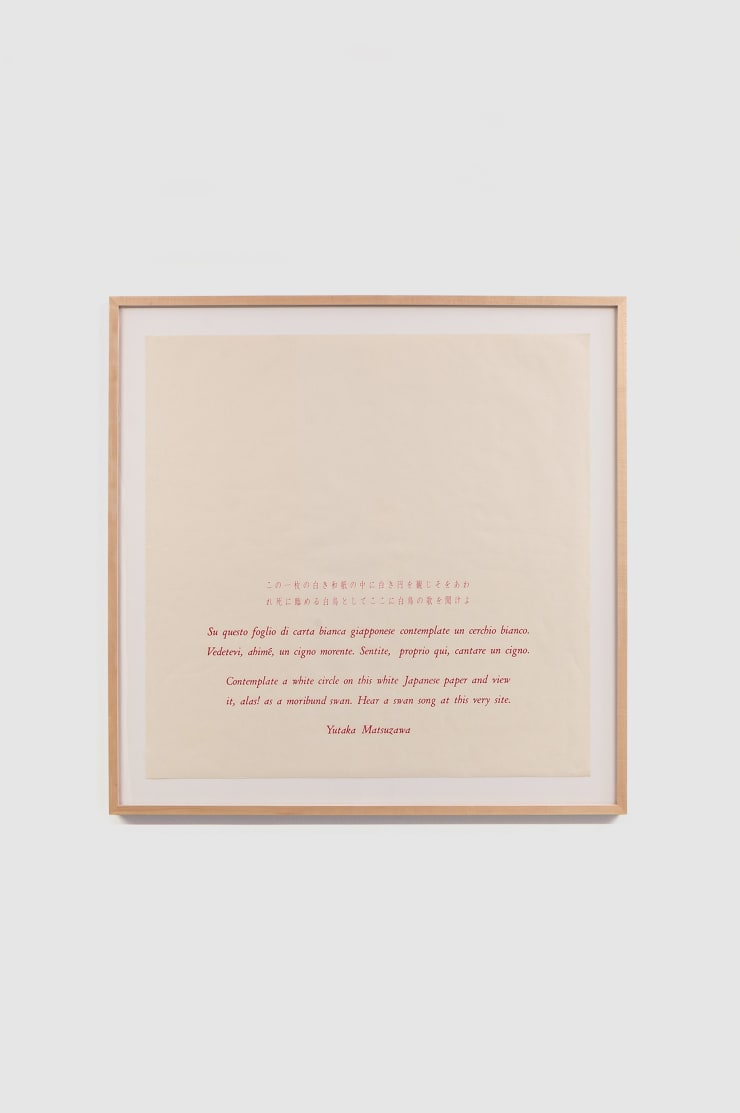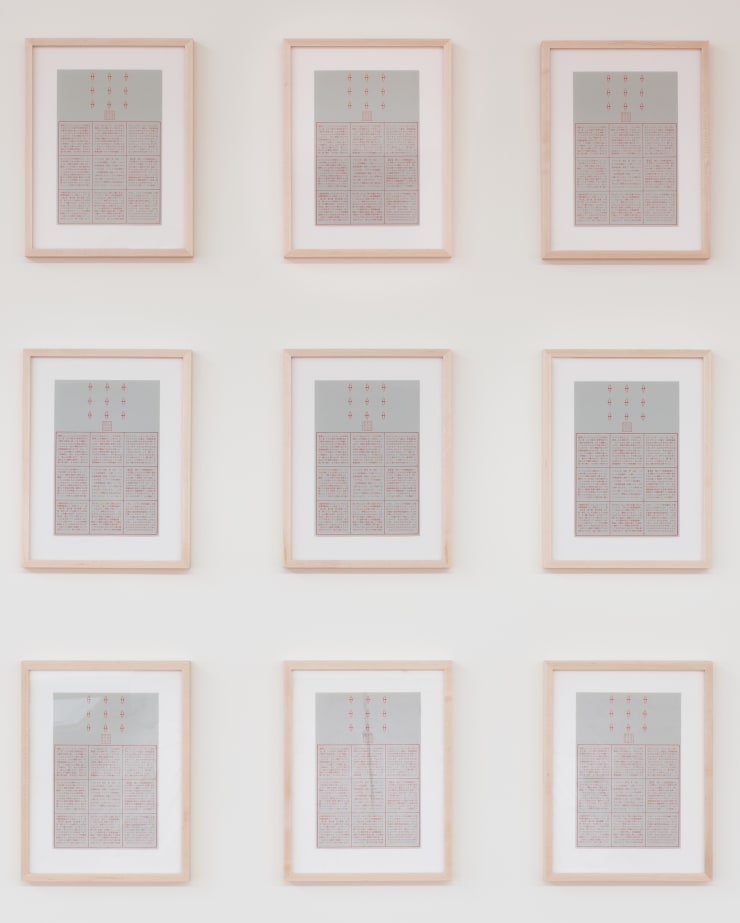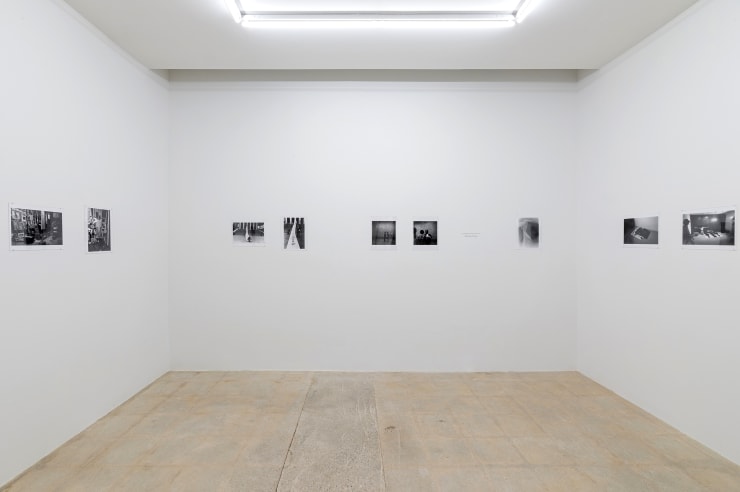Yutaka Matsuzawa
Yutaka Matsuzawa (松澤宥, Matsuzawa Yutaka, February 2, 1922–October 15, 2006) was a pioneering Japanese conceptual artist whose innovative work redefined the boundaries of art through immateriality and meditative visualization. Born in Shimosuwa, Nagano Prefecture, in central Japan, Matsuzawa grew up during Japan’s tumultuous Fifteen-Year War (1930–1945), an experience that profoundly shaped his rejection of conventional artistic and societal norms. After studying architecture at Waseda University in Tokyo (1943–1946), he abandoned the field to pursue poetry and art, teaching mathematics at a night school in his hometown.
From 1955 to 1957, Matsuzawa studied in the United States on Fulbright and Japan Society fellowships, engaging with philosophy, religion, and art history at Columbia University. In New York, he encountered the works of Jackson Pollock, Robert Rauschenberg, and John Cage, which informed his early surrealist explorations. Inspired by parapsychology, he developed his “Theory of Psi,” exploring cognitive abilities beyond the five senses, as seen in works like Psi Bird (1958) and Psi Altar (1961). This earned him the nickname “Mr. Psi.”
A pivotal moment came on June 1, 1964, when Matsuzawa experienced a revelation to “vanish matter,” prompting a shift to text-based, anti-materialist art centered on the concept of kannen (idea or meditative visualization). Works like White Circle (1967) and My Own Death (1970) invited viewers to engage with absence and impermanence, drawing on Pure Land Buddhism and quantum physics. His estate in Suwa became a hub for the Nirvana School, a collective of like-minded conceptual artists, and his work gained international recognition through exhibitions like the Tokyo Biennale (1970) and Venice Biennale (1976).
Matsuzawa’s practice, which synthesized Eastern and Western philosophies, challenged Euro-American conceptualism by emphasizing the invisible and impermanent. His influence endures through exhibitions and the republication of his Quantum Art Manifesto (1988). Matsuzawa died on October 15, 2006, in Shimosuwa, leaving a legacy as a trailblazer of Japanese conceptual art.
-
 Yutaka Matsuzawaψ Box (松澤宥 ψの函), 1983Artist’s book, published by Zōkeisha, TokyoBox: 12 x 11 13/16 x 2 1/4 in (30.5 × 30 × 5.5 cm)
Yutaka Matsuzawaψ Box (松澤宥 ψの函), 1983Artist’s book, published by Zōkeisha, TokyoBox: 12 x 11 13/16 x 2 1/4 in (30.5 × 30 × 5.5 cm) -
 Yutaka MatsuzawaThe Nine Meditation Chambers (九想の室), 197712 handwritten and typed sheetsPaper size: 7 1/8 x 10 1/8 in (18 x 25.6 cm) each
Yutaka MatsuzawaThe Nine Meditation Chambers (九想の室), 197712 handwritten and typed sheetsPaper size: 7 1/8 x 10 1/8 in (18 x 25.6 cm) each
Framed: 11 x 13 1/2 (27.9 x 34.3 cm) each -
 Yutaka MatsuzawaContemplate a White Circle in This White Sheet of Paper (Swan Song) この一枚の白き和紙の中に (白鳥の歌), 1976SilkscreenPaper size: 35 7/16 x 35 7/16 in (90 x 90 cm)
Yutaka MatsuzawaContemplate a White Circle in This White Sheet of Paper (Swan Song) この一枚の白き和紙の中に (白鳥の歌), 1976SilkscreenPaper size: 35 7/16 x 35 7/16 in (90 x 90 cm)
-
 Yutaka MatsuzawaMy Own Death (私の死), 1970Photostat panel35 7/8 x 36 5/8 x 1 1/4 in
Yutaka MatsuzawaMy Own Death (私の死), 1970Photostat panel35 7/8 x 36 5/8 x 1 1/4 in
91 x 93 x 3 cm -
 Yutaka MatsuzawaPsi Corpse (プサイの死体遺体), 1964/ 19959 sheets; offset lithograph, 2nd printingPaper size: 15 1/8 x 10 1/4 in (38.4 × 26 cm) each
Yutaka MatsuzawaPsi Corpse (プサイの死体遺体), 1964/ 19959 sheets; offset lithograph, 2nd printingPaper size: 15 1/8 x 10 1/4 in (38.4 × 26 cm) each
Framed: 21 1/8 x 16 1/8 in (53.6 x 40.9 cm) each -
 Yutaka MatsuzawaPsi Corpse (プサイの死体遺体), 1964/ 199519 sheets; offset lithograph, 2nd printing15 1/8 x 10 1/4 in
Yutaka MatsuzawaPsi Corpse (プサイの死体遺体), 1964/ 199519 sheets; offset lithograph, 2nd printing15 1/8 x 10 1/4 in
38.4 x 26 cm -
 Yutaka MatsuzawaOn "Meaning of Psi" and Psi Chamber,"〈プサイの意味〉および〈プサイ函・Psi Chamber〉, 1961Print13 x 9 1/2 in (33 x 24 cm)
Yutaka MatsuzawaOn "Meaning of Psi" and Psi Chamber,"〈プサイの意味〉および〈プサイ函・Psi Chamber〉, 1961Print13 x 9 1/2 in (33 x 24 cm) -
 Yutaka MatsuzawaPsi Chamber, 196113-1/4 x 9-1/2 inches
Yutaka MatsuzawaPsi Chamber, 196113-1/4 x 9-1/2 inches -
 Yutaka MatsuzawaThe Nine Meditation Chambers (concrete platform)floor
Yutaka MatsuzawaThe Nine Meditation Chambers (concrete platform)floor
installation
with text
-

Yutaka Matsuzawa
Co-curated by Alan Longino and Reiko Tomii Originated by Yale Union, Portland, Oregon September 7 - October 5, 2019 Los AngelesPress: ArtAsiaPacific , Issue 116 Nov/Dec, 2019 Nonaka-Hill is pleased to host an exhibition by Yutaka Matsuzawa (b. 1922; d. 2006, Shimo Suwa, Japan). Known as one of the leading...Read more -

Yutaka Matsuzawa through the lens of Mitsutoshi Hanaga
September 7 - October 5, 2019 Los AngelesNonaka-Hill have organized Yutaka Matsuzawa through the lens of Mitsutoshi Hanaga , a small presentation of the photographer who documented the avant-garde in 1960s Japan, underground and youth culture, and...Read more











